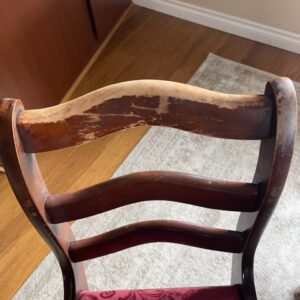I have chairs from a Duncan Phyfe style dinette set (late 50’s early 60’s era). The chairs have places where the finish has worn off down to bare wood. I realize I can’t patch the bare spots(for lack of a better term). I sanded a spot underneath that you can’t readily see and the wood just doesn’t see to be absorbing stain. Assuming they have a spray on tinted finish? What options do I have as far as refinishing goes? I don’t want to strip them and have 6 ruined chairs on my hands.
Discussion Forum
Get It All!
UNLIMITED Membership is like taking a master class in woodworking for less than $10 a month.
Start Your Free TrialCategories
Discussion Forum
Digital Plans Library
Member exclusive! – Plans for everyone – from beginners to experts – right at your fingertips.
Highlights
-
Shape Your Skills
when you sign up for our emails
This site is protected by reCAPTCHA and the Google Privacy Policy and Terms of Service apply. -
 Shop Talk Live Podcast
Shop Talk Live Podcast -
 Our favorite articles and videos
Our favorite articles and videos -
E-Learning Courses from Fine Woodworking
-
-
 Fine Woodworking New England Event
Fine Woodworking New England Event -













Replies
The original finish is likely a factory applied blend of stain, dye, and toners. You will be hard pressed to duplicate the finish with home methods and available materials. In any case, to do your best job, it will be necessary to remove the upholstery and have the wood striped. Even without striping, there is very little you can do without removing the upholstery. Without striping, sanding only will not remove factory sealants that have penetrated the wood that will keep new stain and finishes to penetrate.
Your options now are really strip, sand, and refinish, or sand and paint.
I was afraid that may be the case. I think I’ll strip one chair (it’s an extra) sand it, stain it and if that doesn’t work I may try one of those Rustoleum wood furniture transformation kits
The upholstery probably comes off with 4 screws through the corner blocks underneath.
Yes 4 screws and it’s off at least that parts easy 😁
Have a watch of Thomas Johnson Antique Restoration on YouTube - he does a lot of finish matching - I don't think any one video would show you exactly what you need, but if you watch 10 or so of them you'll learn a lot.
If you use one of those " Restore the finish" products.. if the finish is intact everywhere it might work. If however any place where the original finish is compromised , sun damaged, scratches or worn though it will absorb into those places and leave you with something that looks like a pinto pony. Then your left with stripping it anyway to fix that. Stripping a chair is hard work ,lots of joints and corners and personally I refuse to do it unless the chair(s) have actual value. Options are to A)strip down to bare wood and do a complete refinish,B) clean and sand to remove crud and apply a finish of choice and call the flaws " patina". C) While extremely harsh you can take the chairs and have them dipped. I have a house full of antique cedar Eastlake doors that were painted and that is what I did, otherwise 40 years later I'd still be working on them! Still, after dipping, there will be quite alot of handwork cleaning up after. And finally there is always paint.
It’s looking like paint at this point. If you click the thumbnail in my original post you can see how badly worn the finish is. I sanded one spot and tried stain but it doesn’t seem to be absorbing it. Next I tried using wipe on poly tinted with stain but that was going to take an ungodly number of coats and still look bad. We used the Rustoleum cabinet transformation stuff on our kitchen cabinets 5 or 6 years ago and they are wearing well so I may go that route.
You tried stain, but how about dye? Different properties.
When dealing with Duncan Phyfe style chairs that have worn spots in the finish, stripping them completely might be risky. Instead, you can try refinishing the chairs without stripping. First, sand the entire surface lightly. Then, use a gel stain that matches the existing finish to blend in the worn spots. This can often rejuvenate the chairs without the need for a full strip-down. Test on an inconspicuous area first to ensure a good color match.
Most of the base colorants on this chair type I have seen is a red mahogany dye stain. Roselake is one such color. The next step is to lock in the stain with a topcoat. If you don't have a sprayer, aerosol clears and toners will work. Use a dye toner to retain the clarity. This is where color theory comes in handy. If it is too red, a dusting of greenish dye will kill some of the red. Go carefully. The last few coats are with a clear lacquer in the sheen of your choice.